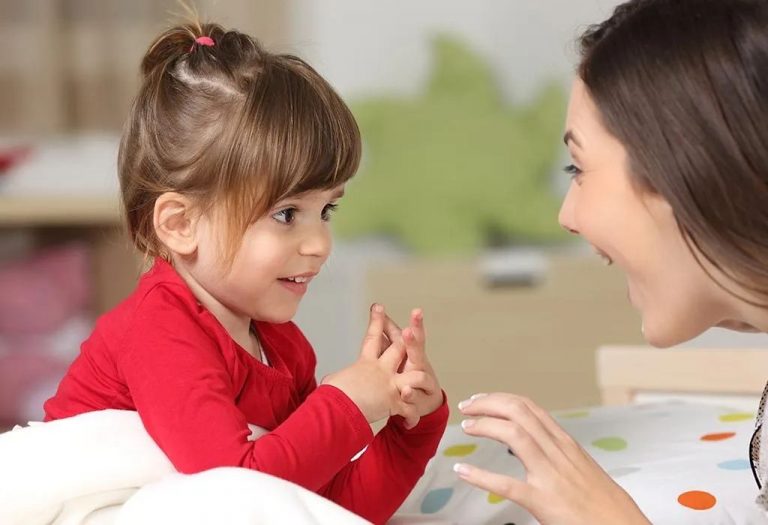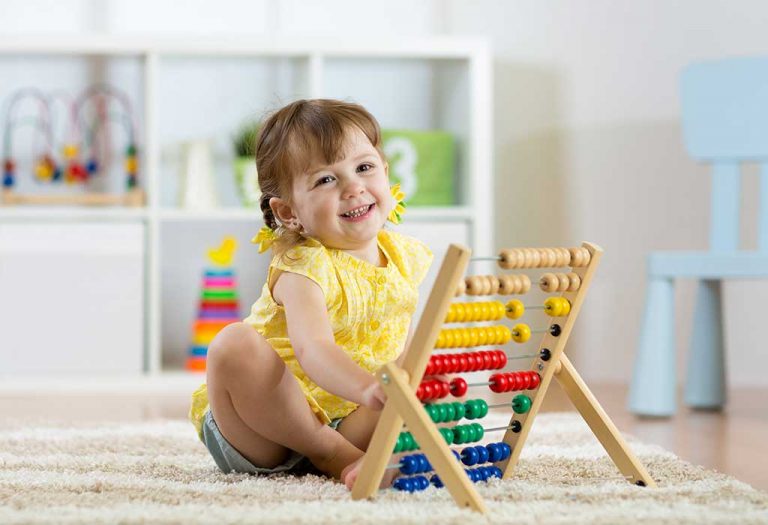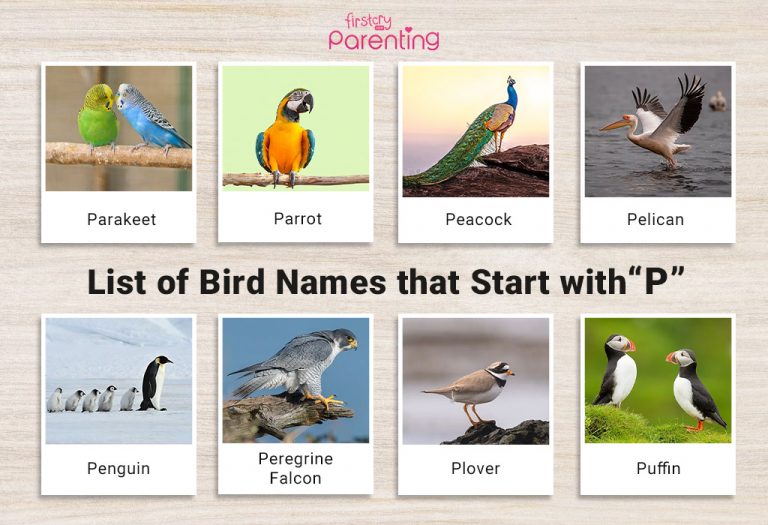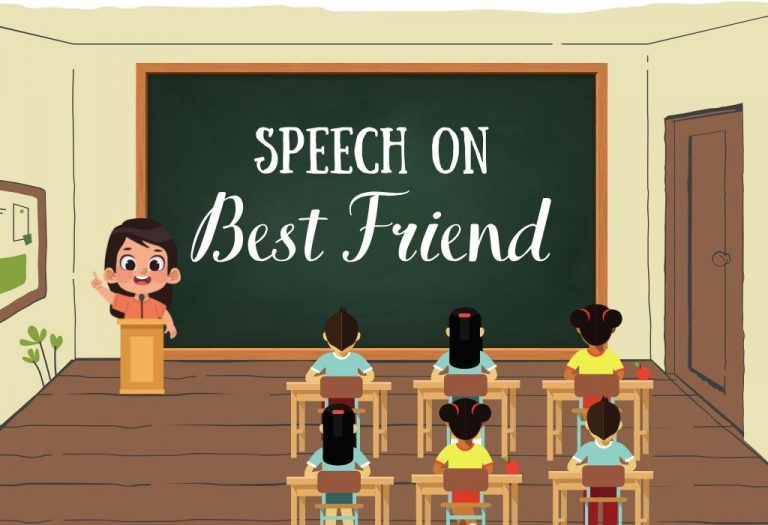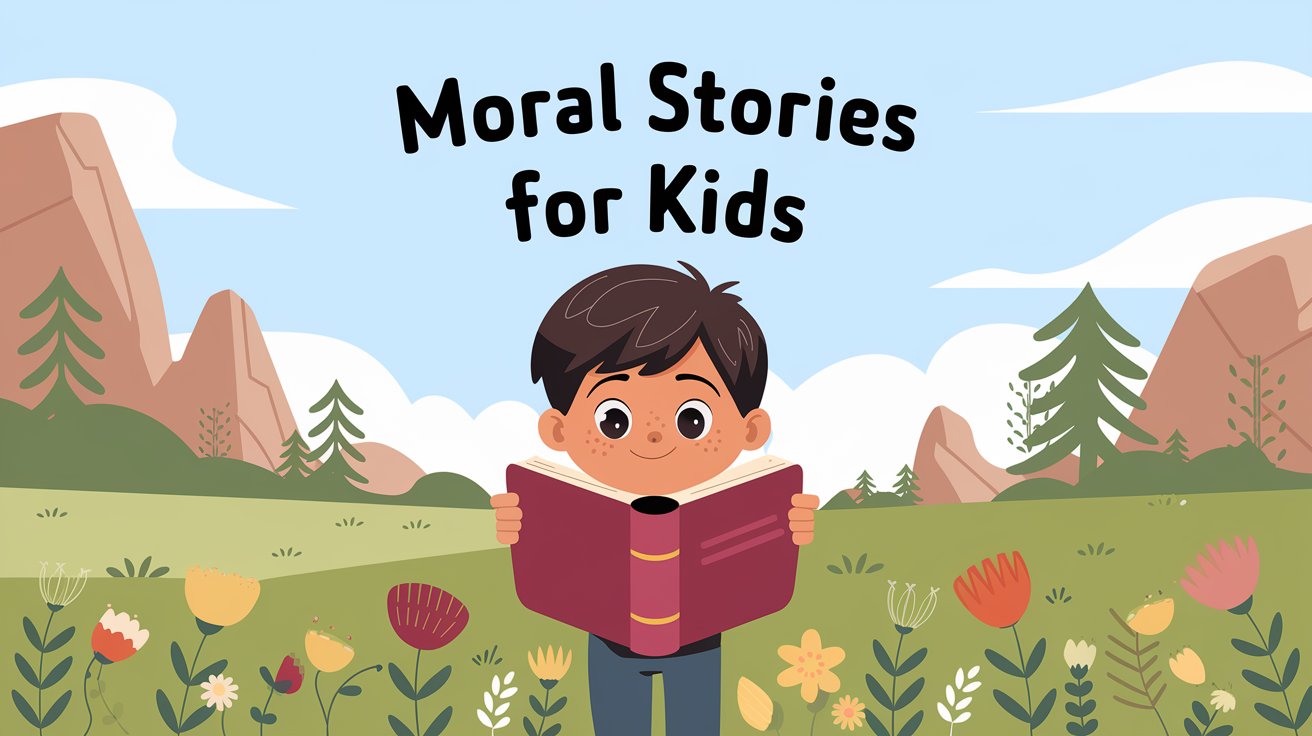Body Parts for Kids: Teaching Your Child About Parts of the Body
As babies grow, their curiosity about their bodies blossoms. They begin to notice their hands, feet, and all the little bits in between. This natural exploration is crucial for their development. As toddlers and preschoolers, they’re like eager explorers, soaking in information about themselves and the world around them. That’s why activities that focus on body parts for children are so important. These body parts activities for preschoolers can be super fun and interactive, like singing catchy songs about body parts or playing games where they get to touch different parts of their bodies. Through these activities, kids not only learn the names of their body parts but also start to understand how their bodies work. This understanding helps them feel more at ease and confident in their own skin, which is essential for their overall growth and development. So, whether they’re wiggling their fingers, tapping their toes, or pointing to their noses, every little movement is a step towards self-discovery and empowerment. Read on to understand how to teach about body parts to little ones.
When Can You Start Teaching Your Child About Body Parts?

There’s no specific age to start teaching your child about the parts of the body. Sometimes, your baby might tend to know the parts himself by listening to body parts songs for children. These can be established in him making attempts to touch his nose when you touch your own. Babies learn a lot through mimicking sounds and gestures, and they will be able to identify many parts, even if they can’t name them on their own. Many kids learn to clap on their own, so associating that action with the phrase “clap your hands” can help them make the connection of which body part is used for which action.
Benefits of Teaching Your Child About Body Parts
Teaching your child about body parts not only educates them about their own body but also promotes body positivity and self-awareness. Here are some benefits of teaching your child about body parts:
- Promotes Body Positivity: Learning about their body parts helps children develop a positive attitude towards their own bodies.
- Encourages Self-Care: Knowing about body parts enables children to understand the importance of taking care of themselves, such as washing hands or brushing teeth.
- Enhances Communication Skills: Being able to identify and articulate body parts improves a child’s communication skills, enabling them to express themselves more effectively.
- Facilitates Safety Awareness: Teaching children about body parts also empowers them with the knowledge to recognize and communicate discomfort or potential dangers to trusted adults.
- Fosters Respect for Diversity: Learning about different body parts and their functions fosters an understanding and appreciation of diversity among people.
Ways to Teach Kids about Body Parts
In order to teach about body parts for kids, there are multiple fun-filled activities and body parts games for kids that you can make use of and help your little one begin taking tiny steps in understanding them.
1. Refer to Animals
Sometimes, kids may not respond to addressing their own body parts or somebody else’s due to repetition. You can opt for using animal soft toys or images and point out that even they have legs and eyes and noses. You can start showing the difference between some animals having a tail but not us. If you have a pet in the house, then nothing like it.
2. Make Use of Props
Give your child a small toy which he can use to point at. So when you say nose, ask him to point at his nose in the mirror or your nose. This can also be combined with a game using stickers. Give him a sticker and ask him to put it on your hand and see if he can do it the right way.
3. Describe Various Functions
Children learn a lot from first-hand examples. Make use of sensory perceptions to help them understand it better. Close your baby’s eyes and say out loud “eyes closed”, “eyes open” and so on. This will help them associate the act of seeing with eyes. Same can be repeated for other senses, especially for the nose, which can help him smell and identify different aromas.
4. Use Visual Aids
The visual perception of kids is the highest and they glean a lot of information from what they see. Use large posters of a human body or even cartoons and use those to tell him about different parts of the human body. As your child grows up, you can make the activity even more interactive. Get a large paper and draw the outline of a human body on it. Let your toddler then draw eyes in the right place, fingers on the hand, and so on.
5. Riddle Me This
You don’t learn much the first time as much as you learn when you need to recall it. Do the same with your kids as well and engage them in simple activities where you ask them questions related to their body parts. Simple things such as “wipe your nose” accompanied by your act of wiping your own nose, can help him understand what needs to be done.
6. Bring on the Music
If nothing else helps, memorization and repetition can break the barrier that’s holding your kid back from understanding body parts. If your kid likes a particular nursery rhyme or any popular song, replace the words with parts of the body and dance to the rhythm while pointing at those body parts and saying the words out loud in the tune of the song. You don’t need to be a lyricist to make it sound good. The aim is to use the tune as a tool for memorization and recall of various actions and body parts.
Body Part Chart for Children
Introducing children to a body part chart can be a fun and educational way to teach them about their anatomy. These charts like the one below, typically feature colorful illustrations and simple labels that make learning engaging and accessible for young minds.
Games to Teach Parts of Body to Kids
Introducing games to teach parts of the body to kids can make learning fun and interactive. These games engage children in hands-on activities that help them identify and remember different body parts while promoting movement and creativity. Here are eight exciting games to consider:
1. Simon Says
In this classic game, one person plays “Simon” and gives commands like “Simon says touch your nose” or “Simon says wiggle your toes.” Kids must only follow commands preceded by “Simon says,” reinforcing body part recognition while encouraging listening skills.
2. Body Part Bingo
Create Bingo cards featuring various body parts instead of numbers. Call out body parts, and children cover the corresponding pictures on their cards. This game enhances visual recognition and reinforces vocabulary.
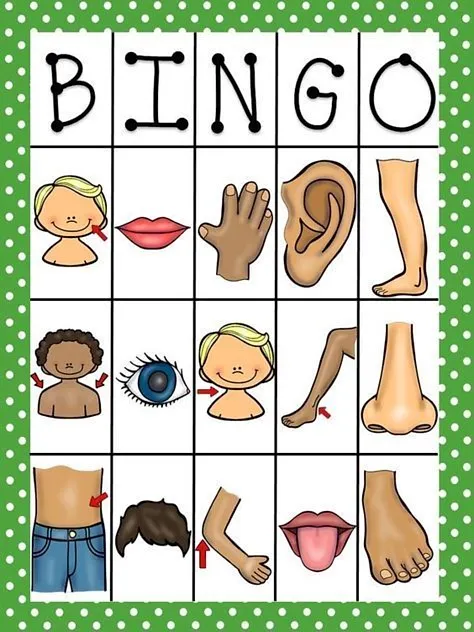
Source: Pinterest
3. Musical Body Parts
Similar to musical chairs, but instead of chairs, use images or cutouts of body parts placed on the floor. When the music stops, children must identify and stand on a body part called out by the facilitator.
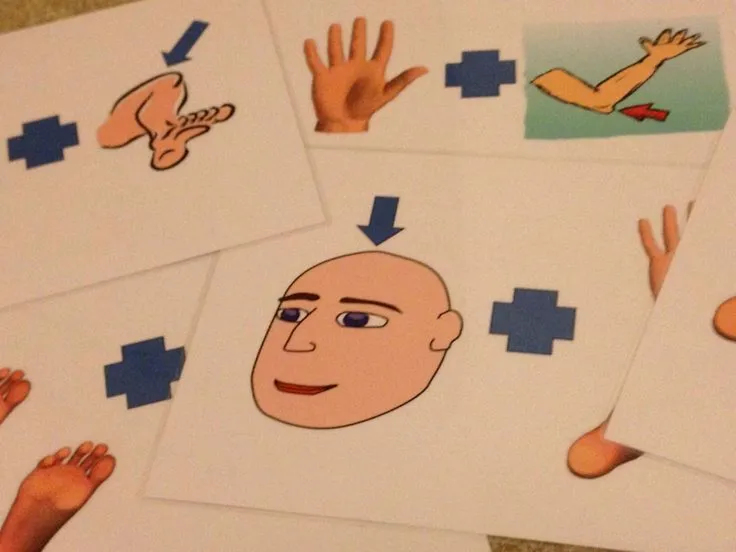
Source: Pinterest
4. Body Part Drawing Challenge
Give children paper and markers, and challenge them to draw a person. Encourage them to label as many body parts as they can, such as eyes, nose, hands, and feet. This game stimulates creativity, fine motor skills, and reinforces body part recognition through hands-on engagement.
5. Body Part Charades
Children take turns acting out different body parts while others guess which part they’re portraying. This game encourages creativity, communication, and reinforces body part recognition.
6. Body Part Memory Game
Create pairs of cards with images of various body parts. Place them face down and take turns flipping over two cards, trying to find matching pairs. This game enhances memory skills while reinforcing body part identification.
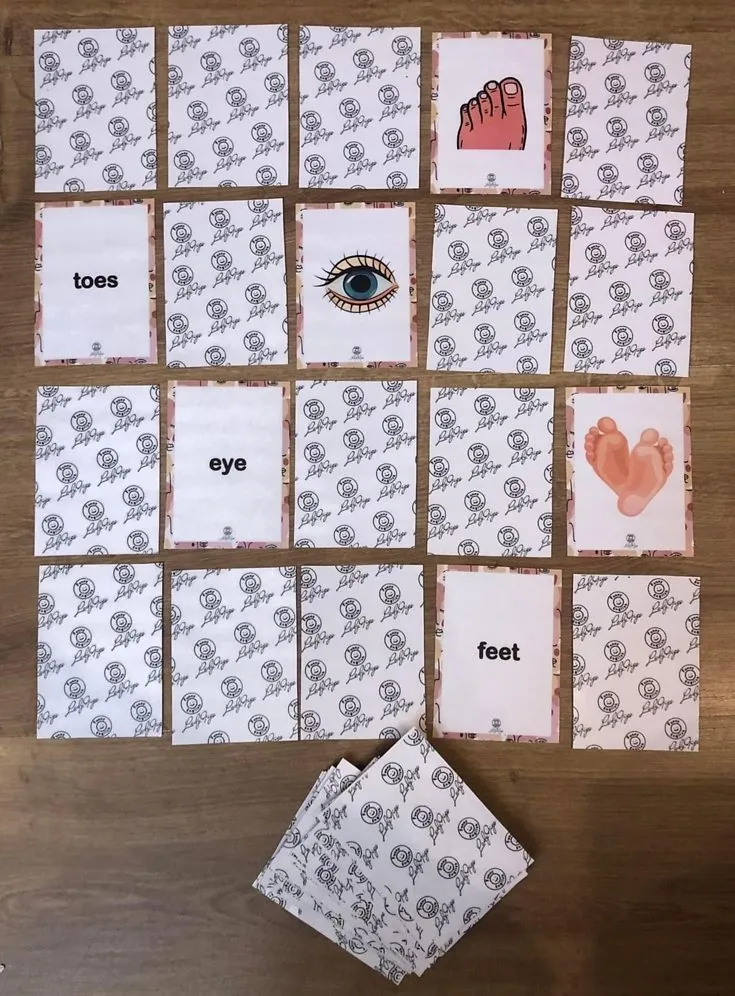
Source: Pinterest
7. Body Part Puzzle
Provide children with puzzles featuring illustrations of the human body. As they assemble the puzzle, they can identify and learn about different body parts. This game promotes problem-solving skills while reinforcing body part recognition.
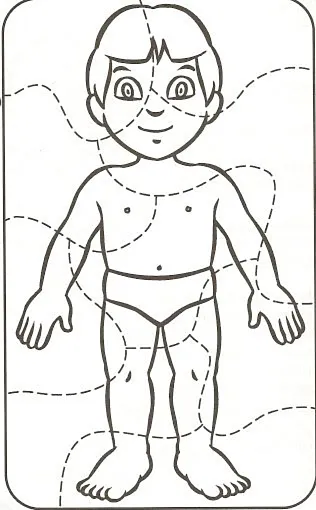
Source: Pinterest
8. Body Part Scavenger Hunt
Hide pictures or toys representing various body parts around the play area. Children search for the hidden items and name the body parts as they find them. This game promotes exploration and reinforces body part identification skills.
How Can You Teach Kids About Private Body Parts?
Teaching body parts to preschoolers is usually restricted to the usual ones that we see. Rarely do parents teach kids about their own private parts. Most of the times these are replaced by nicknames so that they can easily tell us when they need to go pee or have any problems with it. However, it is majorly due to these nicknames that kids start developing a perception of shame and guilt when it comes to addressing the private organs they have themselves.
You don’t need to undertake sex education or teach them the difference between genitals of each gender at this age. But as your child begins to start saying words properly, you can teach the proper words of genital parts, such as “penis” and “vagina” appropriate to the child. Let him address the part by its right name. It is necessary for parents to be comfortable with it as well. If you cringe at the mention of a name that is absolutely normal and is the right word for it, your child will start developing an attitude of looking at private parts with disgust. As your kid starts growing and starts noticing general differences between genders, such as clothing styles, hair length, and so, you can then introduce them to the genital parts of a different gender and keep it at that.
Teaching body parts to toddlers or young kids brings its own set of challenges. Many kids do learn to point to the right parts or indicate their presence in different ways. It is necessary to bundle up private parts along with these as well, so as to not build up any sense of confusion or doubt in the child’s mind about the existence of a body part he does not understand. The less awkward you make it for yourself, the better your child will develop as a well-rounded individual.
FAQs
1. My child seems disinterested in learning about body parts. How can I make it more engaging?
Try to make learning about body parts fun and interactive by incorporating play-based activities that cater to your child’s interests. Use toys or props that involve body parts, incorporate movement and music into lessons, and be patient and encouraging as your child explores and learns at their own pace.
2. Are there any potential concerns I should be aware of when teaching about body parts?
When teaching about body parts, it’s important to use age-appropriate language and ensure that the information is presented in a positive and respectful manner. Additionally, be mindful of cultural or familial norms regarding body awareness and modesty, and approach the topic sensitively based on your child’s individual comfort level.
3. Should I use anatomically correct terms when teaching body parts to young children?
It’s generally recommended to use anatomically correct terms for body parts when teaching children, as it promotes accurate understanding and helps prevent confusion or misconceptions later on. However, the decision ultimately depends on your family’s values and cultural norms.
This was all about body parts for kindergarten kids. As your child grows older, it’s essential that he have some knowledge about different things he may come across in the world and also develops different skills that help him along the way. A great way to do this is by subscribing to an activity box, like Intellikit, which integrates fun with learning. Based on a unique theme each month, each box has interactive activities that involve various types of play, keeping your child occupied for hours on end, while learning something. Subscribe today by entering your child’s age, and receive a box of fun learning right at your doorstep each month!
References/Resources:
1. Waugh. W, Brownell. C; Development of Body Part Vocabulary in Toddlers in Relation to Self-Understanding (Early Child Development and Care); National Library of Medicine; https://www.ncbi.nlm.nih.gov/pmc/articles/PMC4505369/; July 2015
2. Milestones During The First 2 Years; American Academy of Pediatrics; https://www.healthychildren.org/English/ages-stages/toddler/Pages/Milestones-During-The-First-2-Years.aspx
3. Activities to Encourage Speech and Language Development; American Speech-Language-Hearing Association; https://www.asha.org/public/speech/development/Activities-to-Encourage-Speech-and-Language-Development/
4. Learning Body Parts; NHS Oxford University Hospitals; https://www.ouh.nhs.uk/patient-guide/leaflets/files/43709Pparts.pdf
5. How do I talk with my preschooler about their body?; Planned Parenthood; https://www.plannedparenthood.org/learn/parents/preschool/how-do-i-talk-my-preschooler-about-their-body
6. Witt. A, Cermak. S, Coster. W; Body Part Identification in 1- to 2-year-old Children; Research Gate; https://www.researchgate.net/profile/Sharon-Cermak/publication/20978498_Body_Part_Identification_in_1-_to_2-Year-Old_Children/links/0fcfd504e5a86be0ae000000/Body-Part-Identification-in-1-to-2-Year-Old-Children.pdf
7. Nienow. S; Seven Steps to Teaching Children Body Autonomy; Rady Children’s Specialists of San Diego; https://www.rchsd.org/2019/12/seven-steps-to-teaching-children-body-autonomy/
Also Read:
Teaching Your Kids to Write
How to Teach Toddler to Brush Teeth
Ways on How to Teach Your Toddler to Speak
How to Teach Colours to Toddlers and Preschoolers
Helping Your Child Learn Name, Age and Gender
Was This Article Helpful?
Parenting is a huge responsibility, for you as a caregiver, but also for us as a parenting content platform. We understand that and take our responsibility of creating credible content seriously. FirstCry Parenting articles are written and published only after extensive research using factually sound references to deliver quality content that is accurate, validated by experts, and completely reliable. To understand how we go about creating content that is credible, read our editorial policy here.





